Granada Spain – Why It’s Best to Explore It on Foot
We’ve been in Granada Spain for just over twenty-four hours, all of which we’ve spent residing in or exploring the ancient Moorish district known as the Albaicin.
It’s been a very pleasant eye opener, but now it’s time to literally come down from the mountain (well hill) and visit the centre of this wonderful city. I’m one of those travellers who likes to do as much research on a new destination as possible before and during my visit. That doesn’t mean I won’t just strike out with no discernible plan in order to immerse myself in a place which is exactly what Alison and I did in the Albaicin. However, I do want to know in advance what previous visitors thought was worth seeing and doing and what wasn’t. Whether it be through a printed guide book, official internet travel sites, informal reviews like TripAdvisor or simply word of mouth I usually have a list of places I intend to see or visit while I’m at this new place. Just as important as the list, is this question. “What’s the best way to see all this?” In the case of Granada Spain I think I’ve got it figured out, so come along and find out if I’m right.
The invention of the audio guide has been a blessing for everyone except actual guides. Fluent in many languages, the properly done audio guide can provide as much or as little information about any particular place as anyone could wish. You can shut them up at the push of a button, they don’t require tips and are a fraction of the cost of the real thing. I’ve been sold on them since I came across the first one probably not more than twenty years ago. They are now ubiquitous at most major attractions and frankly expected to be. So I guess you’ve figured out the answer to my question above – the best way to explore Granada Spain is with the help of an audioguide. When I wrote this post a company called This Is was offering the service, but it is now offered through the Official Granada Tourism site. For just over €15 plus a refundable deposit you get them for two days which is about right for seeing most of what Granada Spain has to offer and it includes the Alhambra. You also get a map with suggested routes on it along with a description of each stop. The tourism office is right in the middle of the old city, very close to the cathedral.
Plaza Isabel La Catolica
The first stop is a short distance away at what would seem to be the heart of Granada Spain, the Plaza Isabel La Catolica where you’ll find a statue of Queen Isabel (or Isabella as I was taught) giving Christopher Columbus (or Colon as the Spanish call him) the money to go look for a shortcut to the Indies. As statues go, it’s pretty good, if somewhat grandiose.
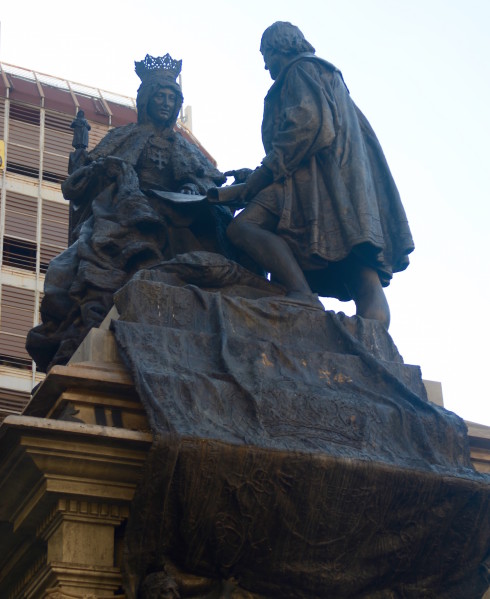
However, if you follow the link above you get a better picture. Apparently Isabella borrowed the money she gave to Columbus from a Jew and never paid it back because she expelled them all shortly after Columbus departed. To top it off she made the burgers of Cadiz build and donate the three ships Columbus used on his first expedition. Apparently the Grenadians have caught on and refer to the plaza as Columbus Square and not by its official name. Looking behind Columbus we see the widest and grandest street in Granada Spain, Gran via de Colon and we head down it looking for our next stop.
Capilla Real, Granada Spain
The Capilla Real or Royal Chapel is one of the most historically important places in Spain as it contains the final resting place of the Catholic Monarchs, Ferdinand of Aragon and Isabella of Castile. Here’s Ferdinand looking like he’s just coming off an all-night bender.
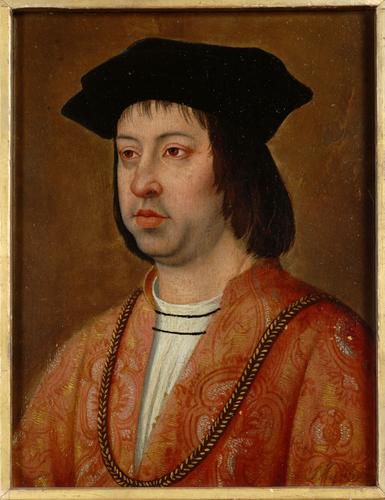
And Isabella looking quite regal in this portrait attributed to the Flemish artist Gerard David.

Anyone who has achieved about a Grade Six education knows that Ferdinand and Isabella were the ones who backed Christopher Columbus in a scheme that went so spectacularly wrong that it ended up making Spain the richest and most powerful nation in Europe for centuries. However, to the Spanish people they are far more important for two other accomplishments – unifying Spain into a single country and completing the reconquista by capturing the last Moorish stronghold in Spain – Granada. We are taught in the west that the Crusades were largely a failed attempt to recapture what were once Christian lands from Muslim conquerors. While in most cases that is true, it does not hold for Spain, portions of which were under Moorish rule for over 800 years before being retaken by Christian forces. As noted, Ferdinand and Isabella along with some of their successors are buried in the Capilla Real which makes it a place of pilgrimage for many Spaniards. They are as much the parents of their country as George Washington is father of his.
The Capilla Real is attached to the side of Granada Cathedral so you can’t get a real feel for what the exterior looks like on its own, but it does have some brilliant stonework mini spires that are very photogenic.
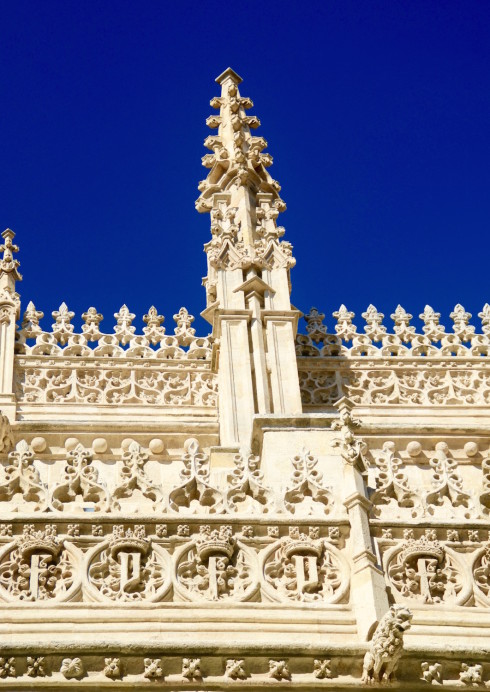
The audio guides come in very handy at Capilla Real as there are no English inscriptions anywhere and they provide far more information than is contained in the English language pamphlet you get at the entrance. To say the place is impressive is an understatement, but there are four things that stood out to me – the main grille, the actual tombs, the main altar and Queen Isabella’s golden crown. Here’s the main grille which is a three tiered work of remarkable workmanship in what is referred to as the plateresque style, a uniquely Spanish combination of Moorish, Gothic and Italian Renaissance elements that overwhelms with its detail and delicacy. If this was the only thing in the Capilla Real it would be worth visiting.
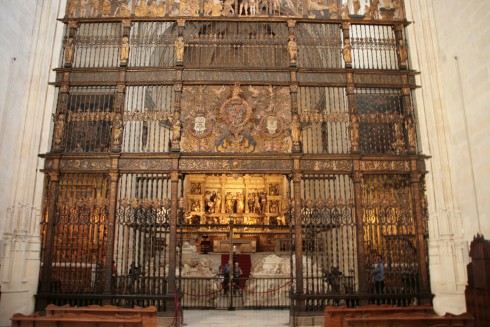
Behind the grille is the mausoleum of Ferdinand and Isabella and here are their effigies. Note that the chivalric fashion of having the feet of a dead man rest by a lion and a woman by a dog was not followed in Spain as it often was in France and England, the lion representing courage and the dog fidelity. Instead, that is a female lion below Isabella symbolizing that she was a king in her own right and not a queen despite being called Queen Isabella. Confusing or what?
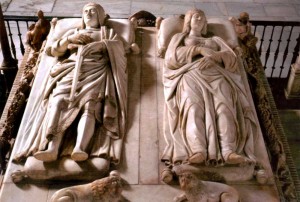
More confusing is the fact that there are actually two couples in the mausoleum and at least half of the pictures on the internet wrongly identify these two below as Ferdinand and Isabella. They are Joanna I and Philip I, a very interesting couple in their own right. Joanna was the daughter of Ferdinand and Isabella and was given the unflattering moniker Joanna the Mad. Philip was a Habsburg from Austria and the first to introduce that noble lineage into the Spanish monarchy. His nickname was Philip the Handsome and he was known more for his philandering than any great deeds. Is it just a coincidence that there are satyrs at the four corners of his tomb? He was also Henry VIII’s brother-in-law, Catherine of Aragon being Joanna’s younger sister and the father of Charles V, one of the most powerful Habsburg rulers.
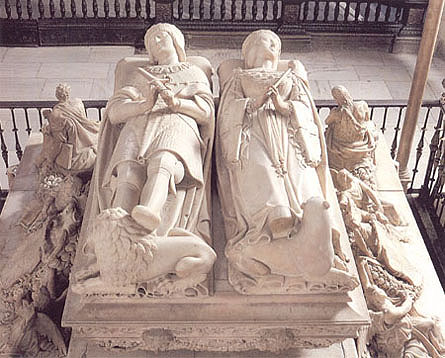
Whether or not you subscribe to the “Great Man” theory of history, there is something almost tangible in the gut about standing before the tombs of people, who by their own actions, changed the course of history in a major way. One could make a good argument that Ferdinand and Isabella would be at or near the top of the list of those who did.
Anyone who has spent any time inside Spanish places of worship quickly comes to realize what they did with those tons of gold and silver they were pillaging from the New World; used it to build monuments to the God they thought was responsible for all this, really quite undeserved, largesse. The Capilla Real is no exception and given its pedigree as among the very first Spanish structures erected in the era of ‘money is no object’, perhaps the forerunner of what was to come. In any event, the main altar of the Capilla Real is a stunning combination of gold, ivory and masterfully carved and painted wooden figures. I’ve commented in other posts on Spain about how surprised I was to discover that the Spanish were absolute masters at creating extremely life like statues out of wood and this altar is alive with them. Based on a design by Felipe Bigarny who made a career out of building Spanish altars, it follows the traditional motif of depicting worldly events on the bottom level and gradually rising through the lives of saints to the life and death of Jesus with God as a somewhat weary worn old man at the top. I know there are those who are disgusted by not only the excess of such pieces, but everything they stand for, but I’m not one. The bottom line is this is is a beautiful piece of art and the more you look at it the more you see. It’s an art gallery disguised as an altar.
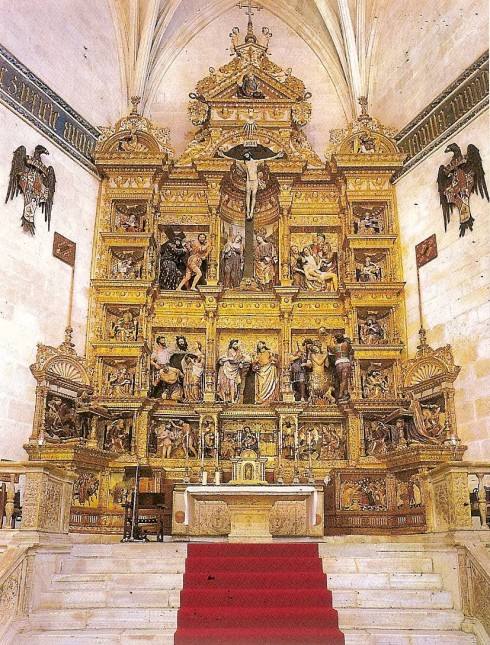
The visit to the Capilla Real ends in the large one room Sacristy Museum which contains a number of items not to be missed including Queen Isabella’s crown which is exactly what you see her wearing in the statue with Columbus. It’s simple, yet regal. And unlike the British crown jewels in the Tower of London you aren’t whisked by it on an escalator, but can stand and admire it along with her sceptre and Ferdinand’s sword, for as long as you want. Also there’ll probably be about a thousand less people around as well.
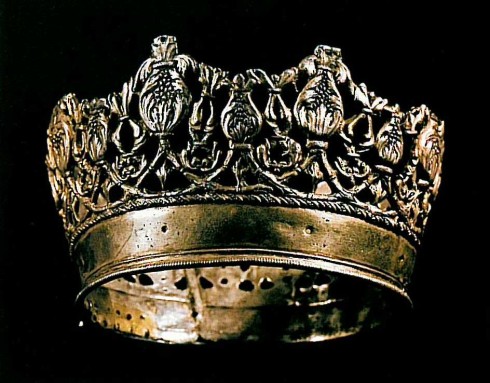
There are a couple of surprisingly rare paintings in the Sacristy including the only Botticelli exported from Italy during the painter’s lifetime, which belonged to Isabella.
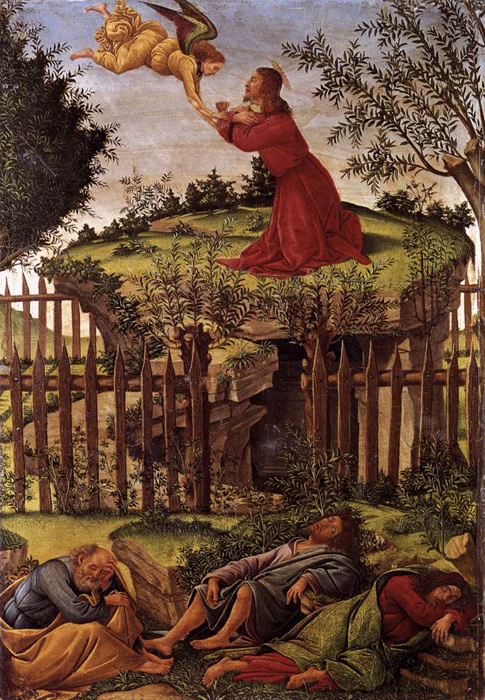
By now it’s lunchtime and we decide to postpone our visit to Granada cathedral until after we get some refreshment. The people from whom we are renting the apartment have recommended nearby Cunini restaurant for a seafood repast and we arrive to find the bar area totally packed, but are led out to the restaurant part out back. This is a lovely room done all in hues of blue. The waiters are jacketed and every other customer that we saw were either business people or well dressed Spanish couples. Despite this the place is not snooty and we had very prompt and courteous service.
If you don’t like seafood you wouldn’t come here, but if you do it’s really good, especially if you want to try something completely different, like for example goose neck barnacles.
We were here for lunch so stuck to soup and an appetizer. I found the seafood soup very good although it could have used a shot of hot sauce to give it a little more zip. The garlic soup was excellent and not over the top like some are so that you can’t talk to anyone for days.
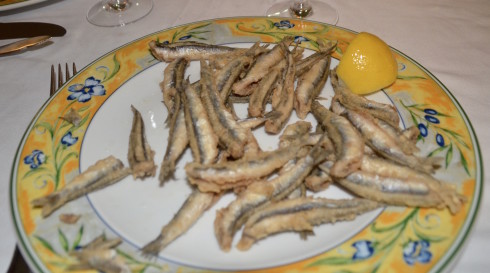
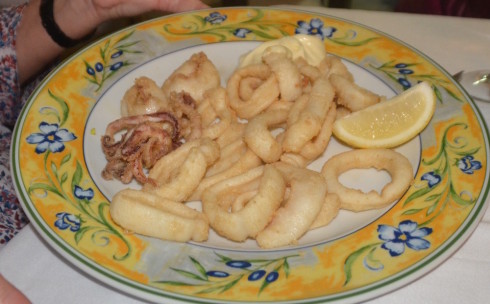
The fried anchovies and calamari were both good, but frankly the soup servings were so large we could only get through half of each. They also give us a small bowl of seafood paella and some lovely rolls. A bottle of the recommended Marques du Riscal white was excellent value at 16 euros. We shared a flan for dessert.
In the next post we’ll continue our walking audio tour of Granada Spain. Please come along.

